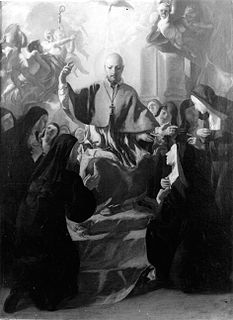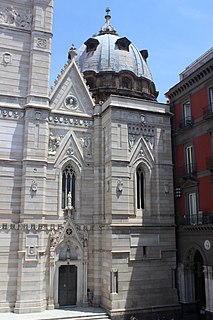
Salvatore Monosilio was an Italian painter of the 18th century, active in a late-Baroque style in Rome.

Salvatore Monosilio was an Italian painter of the 18th century, active in a late-Baroque style in Rome.
He was born and had initial training in Messina, Sicily. But traveled to Rome to be a pupil of Sebastiano Conca. He remained in Rome, painting the ceiling of a chapel in the church of San Paolo alla Regola. For the School of the Padre Pie, he painted a St Giuseppe Calasanzio receives stigmata. He painted a San Pasquale Baylon for the third chapel in the church of Santi Quaranta Martiri e San Pasquale Baylon. He also painted in Ascoli Piceno. He restored some portraits of popes in the Vatican collections under the direction of the canon Marangoni. He sent to Messina two canvases for the Jesuits and a depiction of the titular saint for San Andrea Avellino. His works were incised by Michele Sorello. [1]

Sebastiano Conca was an Italian painter.
The year 1747 in architecture involved some significant events.

San Francesco a Ripa is a church in Rome, Italy. It is dedicated to Francis of Assisi who once stayed at the adjacent convent. The term Ripa refers to the nearby riverbank of the Tiber.

Sant'Andrea delle Fratte is a 17th-century basilica church in Rome, Italy, dedicated to St. Andrew. The Cardinal Priest of the Titulus S. Andreae Apostoli de Hortis is Ennio Antonelli.

Lorenzo de Caro was an Italian painter, active in the late Baroque style in his native city of Naples.

Giuseppe Bartolomeo Chiari, also known simply as Giuseppe Chiari, was an Italian painter of the late-Baroque period, active mostly in Rome.
Onofrio Gabrieli or Gabriello was an Italian painter of the Baroque period.

Giuseppe Nicola Nasini was an Italian painter of the Baroque period, active in Rome and Tuscany.

Antonio Filocamo and his brother Paolo were Italian painters of the Baroque period.

San Francesco della Vigna is a Roman Catholic church in the Sestiere of Castello in Venice, northern Italy.

Antonio Barbalonga or Barbalunga, also called Antonio Alberti, was an Italian painter of the Baroque period.
Andrea Suppa was an Italian painter and architect.

The Royal Chapel of the Treasure of St. Januarius, or the Reale cappella del Tesoro di San Gennaro, is a chapel located in the Cathedral of Naples, Italy, and dedicated to St. Januarius, patron saint of the city. This is the most lavishly decorated chapel in the Cathedral, and contains contributions by the premier Baroque artists in Naples.
Giuseppe Crestadoro was an Italian painter.
Luigi De La Forest was an Italian-French painter, who was active in Modena.

Santi Quaranta Martiri e San Pasquale Baylon is a Roman Catholic church, built in a late-Baroque style, located on Via San Francesco a Ripa in the Rione Trastevere, Rome, Italy.
Litterio Paladino or Paladini (1691-1743) was an Italian painter of the 18th century, active in a late-Baroque style in Rome and his native Messina, Sicily. His first name is also spelled Letterio.
Giuseppe Paladino or Paladini was an Italian painter of the 18th century, active in a late-Baroque style in Messina, Sicily.
Antonio Bova was an Italian painter, active mainly in Sicily.
Giuseppe Zattera (1826-1891) was an Italian painter, mainly depicting landscapes and vedute, but also some sacred subjects.